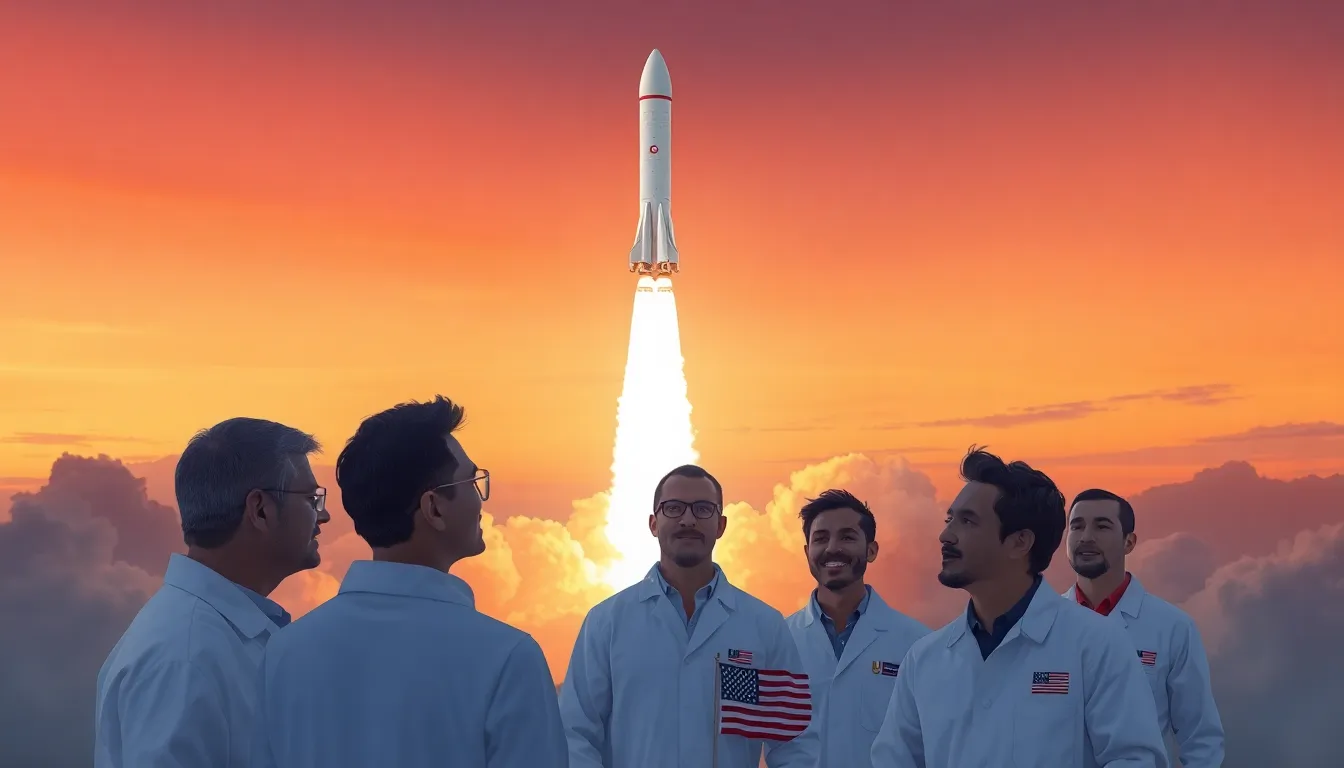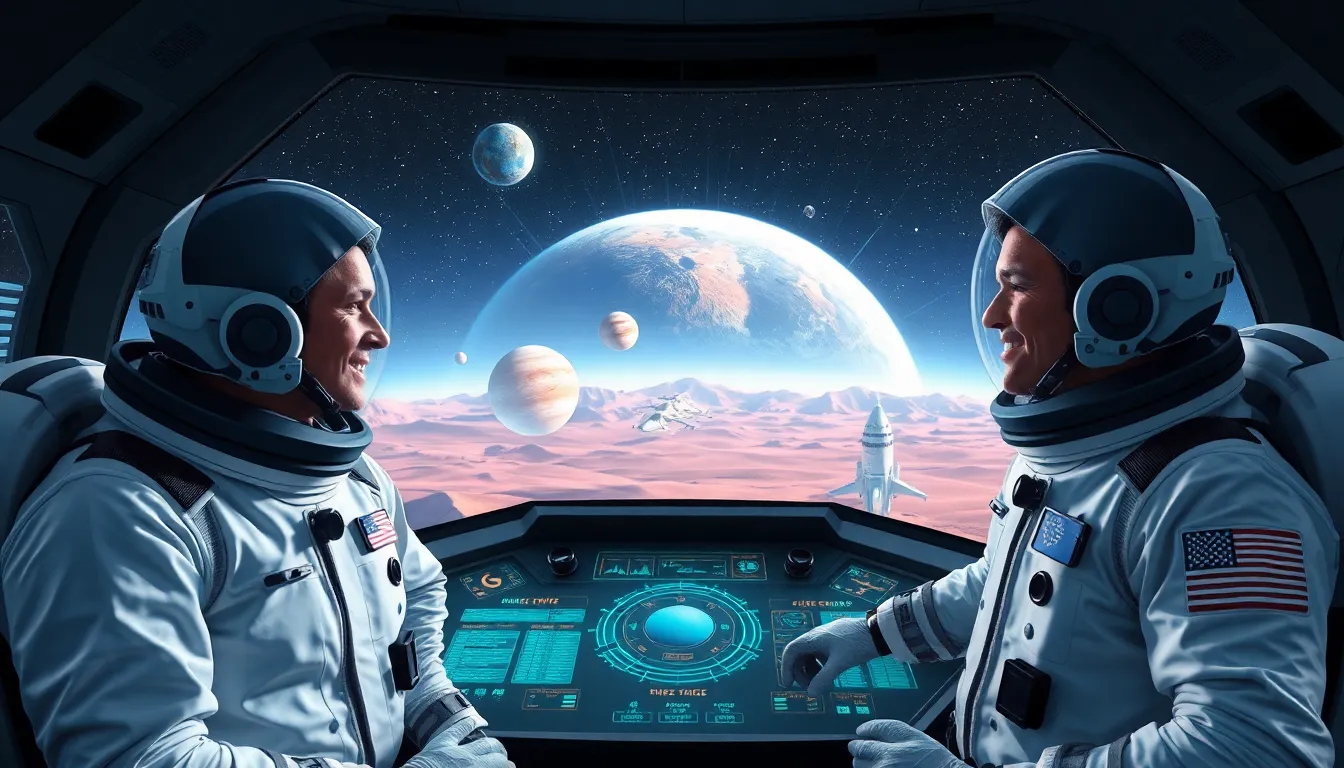As humanity stands on the brink of a cosmic revolution, future space technology promises to catapult us into a new era of exploration and innovation. Gone are the days when space travel was the stuff of science fiction and childhood dreams. With advancements in propulsion systems and artificial intelligence, the universe is no longer just a twinkling backdrop; it’s a playground waiting to be explored.
Imagine zipping around the solar system in a sleek spacecraft powered by renewable energy, all while avoiding the occasional asteroid like a pro. From colonizing Mars to mining asteroids for resources, the possibilities are as vast as the universe itself. Buckle up as we dive into the thrilling world of future space technology and discover how it might just change life on Earth as we know it.
Table of Contents
ToggleFuture Space Technology Overview
Future space technology promises transformative advancements that enhance space exploration and utilization. Innovative propulsion systems, such as ion drives and plasma engines, significantly increase travel speeds, enabling quicker journeys across the solar system. Artificial intelligence (AI) plays a crucial role in spacecraft navigation and decision-making, facilitating autonomous operations during missions.
Renewable energy sources are prominent in the design of future spacecraft. Solar sails and nuclear thermal propulsion systems will harness energy more sustainably, reducing dependence on traditional fuels. Human presence on other planets becomes more feasible with advanced life support systems, offering better sustainability for long-term missions on Mars and beyond.
Mining asteroids opens new frontiers for resource acquisition. Future technologies may include robotics capable of extracting minerals and transporting them back to Earth. These innovations promise to alleviate resource scarcity and support growing demands on Earth.
3D printing technology stands to revolutionize in-space manufacturing. With the capability to create tools and components from local materials, astronauts can enhance mission flexibility and reduce the need for extensive supplies. Such capabilities enable self-sufficiency during prolonged space missions.
Communication technologies will see upgrades, too. Laser communication systems might replace traditional radio waves, allowing faster data transmission between spacecraft and Earth. This shift ensures timely and effective communication during critical missions.
Space tourism emerges as a viable industry, thanks to advancements in safety and affordability. Suborbital flights and lunar vacations offer extraordinary experiences, motivating investment in further developments. Collectively, these advancements delineate a future in which space becomes more accessible and engaging.
Emerging Innovations

Innovations in space technology are rapidly developing, shaping the future of exploration and utilization. Key advancements include reusable rockets and advanced spacecraft propulsion systems.
Reusable Rockets
Reusable rockets play a significant role in reducing launch costs. SpaceX’s Falcon 9 successfully demonstrates this technology, allowing for multiple flights with the same hardware. Rockets that land vertically can streamline missions and promote sustainability. By reusing components, organizations can allocate resources to other critical developments, expanding opportunities for various missions. Additionally, companies like Blue Origin are developing similar technologies to enhance accessibility to space.
Spacecraft Propulsion Systems
Spacecraft propulsion systems evolve with innovative solutions that promise faster travel. Ion drives and plasma engines offer efficient alternatives to traditional chemical propulsion. These systems can attain higher speeds, shortening travel times within the solar system. NASA’s Advanced Propulsion Physics Laboratory is exploring these technologies, targeting missions to Mars and beyond. Utilizing renewable energy sources, such as solar sails, extends mission durations while reducing environmental impact. Collectively, these advancements mark a significant shift, allowing for more ambitious exploration initiatives.
Artificial Intelligence in Space Exploration
Artificial intelligence significantly enhances space exploration by enabling advanced autonomous systems. It empowers spacecraft to operate independently in the challenging environments of space.
Autonomous Navigation
Autonomous navigation leverages AI algorithms to allow spacecraft to chart their course without human intervention. AI sensors process environmental data, ensuring optimal navigation among celestial bodies. Systems like NASA’s Mars Rover utilize this technology for real-time adjustments during exploration. With enhanced machine learning, spacecraft predict potential obstacles and adapt routes accordingly. Mars missions showcase how AI-driven navigation increases efficiency, reduces risk, and facilitates longer-duration missions.
Data Analysis and Decision Making
Data analysis is critical in converting vast amounts of information gathered during missions into actionable insights. AI tools analyze complex datasets quickly, identifying patterns that humans might overlook. This capability improves decision-making regarding mission parameters and scientific inquiries. Advanced AI systems support engineers by offering predictive analytics, which can enhance mission success rates. Continuous data feedback loops allow for real-time adjustments to experiments and operational protocols during missions.
Sustainable Space Practices
Sustainable practices are crucial for the future of space technology. They ensure that space exploration does not come at the expense of the environment or safety.
Space Debris Management
Space debris poses significant risks to operational spacecraft. Effective management strategies involve tracking and removing defunct satellites and fragments to mitigate collisions. New technologies aim to capture and deorbit larger debris pieces using nets or harpoons. Additionally, guidelines for satellite design are necessary, encouraging end-of-life measures like controlled re-entry. These efforts improve the safety of current missions while safeguarding future possibilities in space.
In-Situ Resource Utilization
Utilizing resources found in space enhances mission sustainability. In-situ resource utilization (ISRU) focuses on extracting materials, such as water and minerals, from celestial bodies. For instance, lunar ice can supply water, support human hydration, and generate fuel, welding and oxygen. Technologies such as robotic mining and refining systems will facilitate resource extraction on asteroids and Mars. By reducing reliance on Earth-supplied materials, ISRU lowers costs and extends mission durations, making exploration feasible and efficient.
The Role of International Collaboration
International collaboration plays a pivotal role in advancing future space technology. Many countries recognize that pooling resources accelerates innovation and enhances exploration efforts. Collaborative projects, like the International Space Station, showcase the benefits of shared knowledge and technological expertise across borders.
Countries engage in joint missions to build more efficient spacecraft and launch systems. Partnerships between organizations such as NASA, ESA, and Roscosmos enable the sharing of data and research, directly benefiting ongoing missions. Global cooperation allows for a more comprehensive understanding of space phenomena, as scientists from diverse backgrounds contribute unique perspectives.
Funding joint initiatives elevates collective capabilities in developing advanced technologies. For example, the Artemis program aims to land humans on the Moon, involving various nations in the establishment of sustainable lunar exploration. These partnerships promote resource sharing, including propulsion technology and scientific instruments.
International frameworks also support regulatory measures for sustainable practices in space. Collaborative efforts focus on addressing space debris management through joint technological solutions. Countries work together to track and mitigate the risks posed by defunct satellites and orbital debris, ensuring safe navigation for current and future missions.
Furthermore, educational and outreach programs strengthen the global interest in space exploration. Involving students and researchers from different countries builds a diverse talent pool equipped to tackle complex space challenges. Increased public engagement fosters a sense of global stewardship and responsibility for space resources.
International collaboration enriches the field of space technology by combining expertise, resources, and research. Such partnerships foster innovation while promoting sustainability, ensuring that future space endeavors benefit humanity as a whole.
The future of space technology holds immense promise for humanity. As innovations continue to unfold they pave the way for unprecedented exploration and resource utilization. The integration of advanced propulsion systems and artificial intelligence will not only enhance travel efficiency but also ensure safer missions across the solar system.
Sustainable practices and international collaboration are crucial to addressing challenges like space debris and resource management. By prioritizing these aspects future space endeavors can thrive while minimizing environmental impact.
With each advancement the dream of exploring distant worlds and harnessing celestial resources becomes more attainable. The next era of space exploration is not just a possibility; it’s an exciting reality waiting to unfold.




